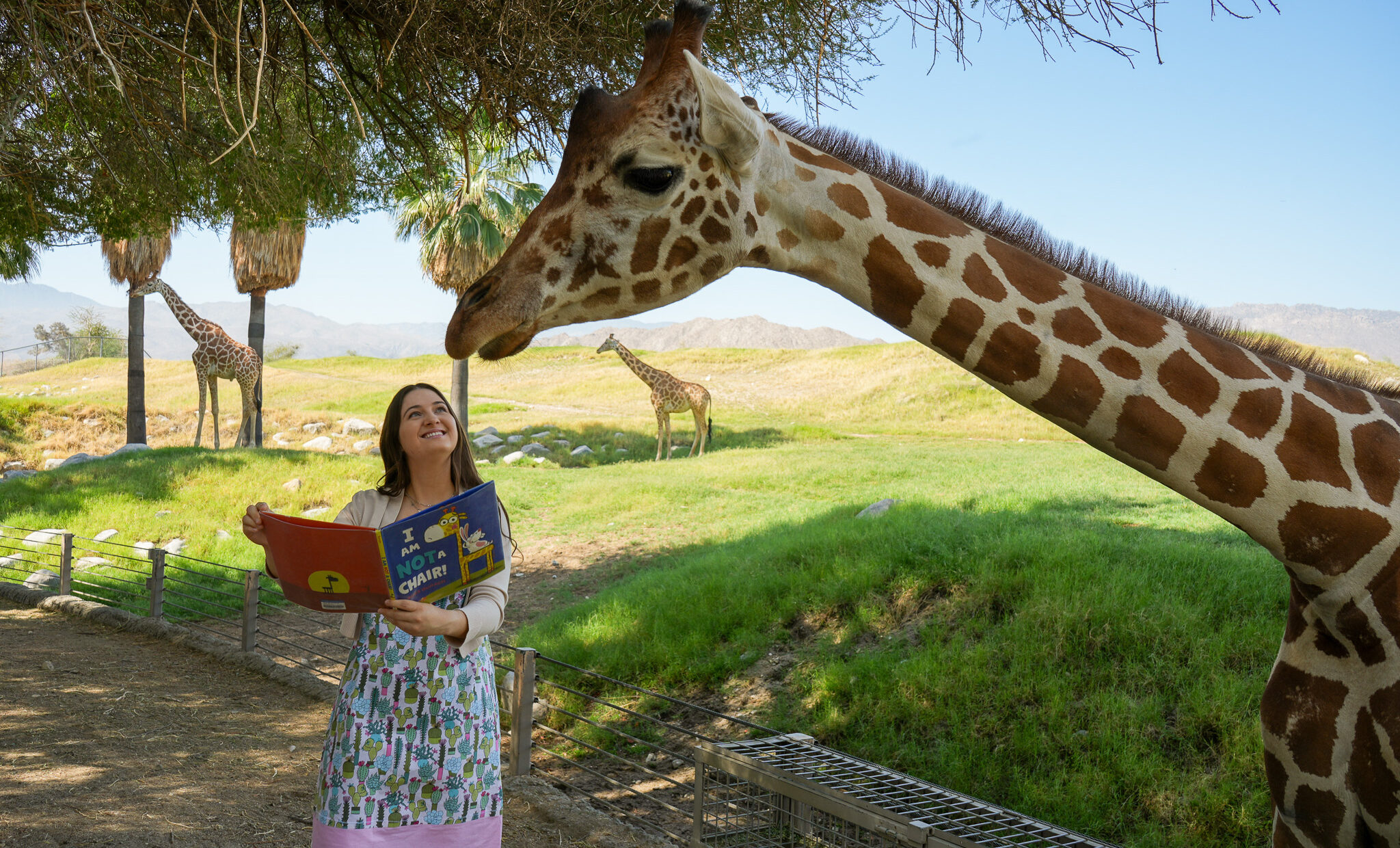Striped Hyena
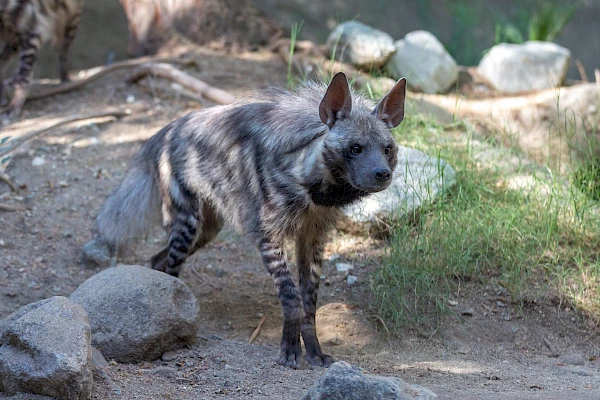
Dog-like in appearance, the Striped Hyena has a big sturdy head. Striped hyena faces are generally black with a black patch of fur under the chin and large pointed ears. Their front legs are longer than their hind legs. Their fur is grey-brown with vertical black stripes along the sides and legs and they have a thick mane that runs from the nape of the neck to the tip of the tail. Their vocalization is a soft howl or snarling sound and they have elaborate greeting rituals.
Their diet includes carrion, tortoises, small animals, livestock, insects, vegetables and fruit. Their jaws are strong with large teeth for crushing bone. Almost completely nocturnal, hyenas forage alone or in pairs. Although they occasionally share large carcasses, group members rarely eat together, avoiding direct competition for food which may be brought back to the den for their cubs.
They have no real predator; however, because they feast on the kills of other, larger predators, confrontations are inevitable and because they are solitary, they tend to back down rather than fight larger carnivores.
They mature at two to three years and can breed at any time of the year. After a gestation of about 90 days, two to four pups are born which are weaned at four months.
Grevy’s Zebra
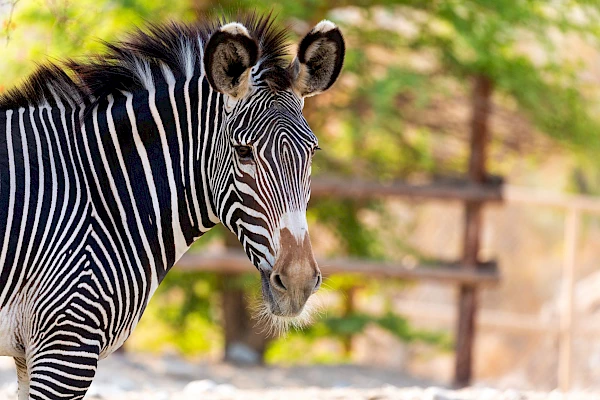
They are horse-like with big, rounded ears, a long, narrow head with very narrow and numerous black stripes on body and legs, but not the belly or around the base of the tail. Grevy‘s zebras are the largest of all wild equids.
Grevy’s don’t form herds like other equines; instead one male defends a small territory with a watering hole. Females who wander into the territory mate solely with the resident male. One foal is born after a gestation period of approximately 13 months, usually between May and August, although they can breed all year. The foal has brown stripes and a mane which stretches from shoulder to tail, and can stand on its feet within one hour of birth, running with the herd after only a few hours. They reach independence from the mare sooner than other equids. Grevy’s eat mainly grass and spend most of the daylight hours grazing. They prefer tender shoots but usually have to eat coarser grass. Leaves, bark, buds and fruit are also eaten. Their predators are primarily lions and African wild dogs.
Greater Kudu
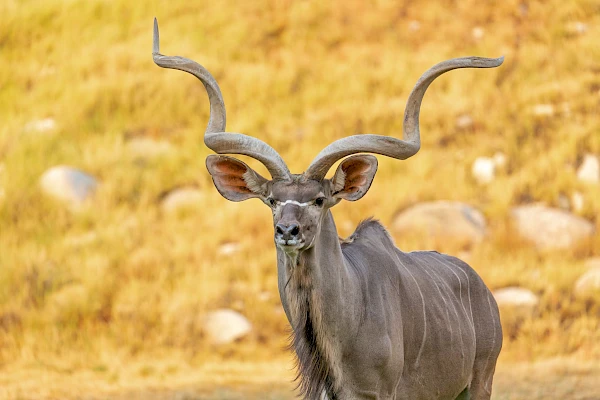
This antelope is easily distinguished by the male’s spectacular spiral horns, and the six to ten thin pale stripes against its tawny-brown to grey-brown body. Female greater kudus are smaller than males, and lack the impressive horns. The coat color of the females is also different, varying from sandy yellowish-grey to russet, against which the thin stripes are conspicuous. Both sexes have a crest of hair that runs along the middle of the back and forms a mane, and there is a distinct white band across the face between the eyes. Their large, rounded ears give a slightly comical appearance.
They are shy and their large ears are extremely sensitive to noise. If they can they will move away from potential predators but if they have to flee they do so with large jumps. Despite their bulky size, greater kudus are remarkably agile and are surprisingly adept at jumping.
Giraffe

Giraffe spend much of their day eating leaves, buds and twigs, especially from acacia trees.
Surprisingly, giraffe only need 530 minutes of sleep per day.
Giraffe are threatened by habitat loss, civil unrest, poaching and ecological changes. The Living Desert actively supports conservation education programs in Tanzania. Learn more about our conservation efforts.
Fennec Fox
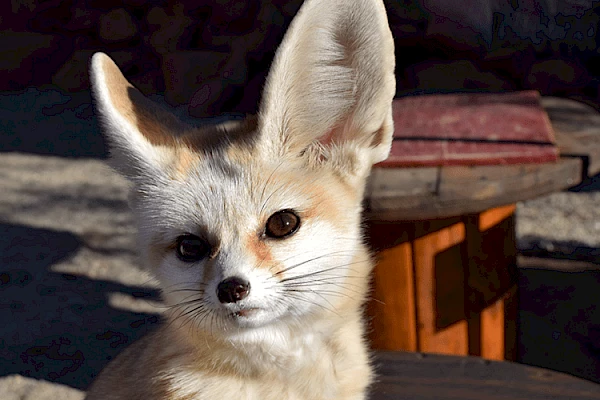
Primarily nocturnal, they live in burrows lined with soft material such as feathers and bits of fur. Fennecs are so quick and agile that they seem to disappear vertically when they dig.
The smallest, palest of all the foxes, fennecs also have the largest ears relative to body size of any canid, plus a bushy, black-tipped tail. Their fur varies from reddish cream to almost white and is very thick to keep them warm on cold nights. They have thick fur between their toes, which helps them to move quickly and quietly on sandy surfaces.
They are omnivorous, eating plant material, small rodents, birds, eggs, lizards and insects such as locusts. They drink water when it is available but can survive for long periods on the moisture obtained from their food.
They are hunted by larger predators such as jackals, wild cats, raptors and man. They often live in small groups of up to 10 burrows. Males and females may pair for several breeding seasons and both parents defend the burrow site, but only the female enters. They breed once a year in January or February with litters of 2-5 young born in March or April.
Dromedary Camel
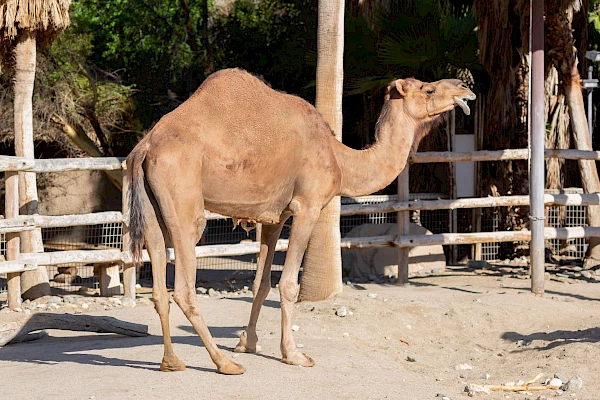
Dromedary camels have a single hump composed of fat, which stores food for times of need and lips that are thickened to allow consumption of thorny plants. They are caramel or sandy brown in color; but can range from almost black to nearly white. Their hair is longer on the throat, shoulder and hump areas. Their left and right legs move in unison, giving them a rolling gait and distributing weight to the soles of their feet rather than the toe tip like other ungulates. Their splayed feet are callused for walking on hot sand, and long eyelashes, bushy eyebrows, sealing nostrils and fur-lined ears protect against sandstorms.
Dromedary Camels can eat a variety of vegetation, including dry, thorny plants, and can drink as much as 30 gallons of water in a short period. They can survive up to 10 months without free water and a water loss exceeding 40 percent of body weight. The fat reserve stored in their hump serves as energy when they go for long periods without food.
Dromedary Camels can mate throughout the year, but peak births coincide with the season of maximum plant growth. They give birth to one offspring after a 13-month gestation.
Klipspringer
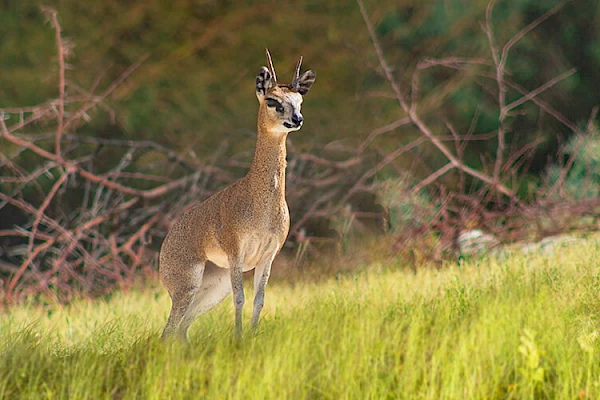
Gracefully and quickly, they spring between rocks to search for food or evade predators. Primarily active in the morning or late afternoon hours, klipspringers react immediately to the sight of predators and the alarm call of other animals. Adults form monogamous pairs and use vocalizations to communicate. Threats: Predator.
Leopard Tortoise
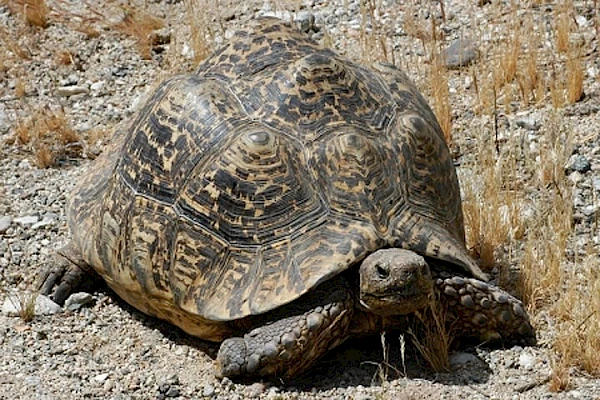
They are large and attractively marked, with high, domed carapaces. Their leathery skin is cream to yellow in color, and their carapaces are marked with black blotches, spots or even dashes or stripes, each individual’s markings being unique.
They are herbivorous and graze extensively upon mixed grasses. They also eat succulents and thistles. Both eggs and young are easy prey for monitor lizards, storks, crows and small mammals.
They are very long-lived animals with life spans up to 100 years, and they seldom mature until between the ages of 12 and 15 years. “Courting” consists of males ramming females. After mating, females dig a hole and lay between five and 18 eggs which take from 120 to 150 days to hatch.
Like most tortoises, they can retract their head and feet into their shell in defense when threatened. Also, like all tortoises and turtles, their mouth is a “beak”. Their hind legs are very like an elephant’s legs and their front legs are almost paddle-shaped with “pigeon-toes” and a row of small “nails”. They can move very fast on these legs and maneuver easily over rocky terrain. Young tortoises have even been observed climbing.
Meerkat
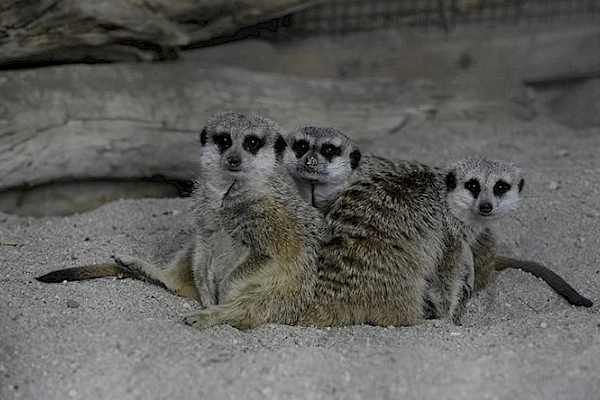
Meerkats have small slender bodies, tan or gray with dark bands across the back and sides, a pointed nose, big dark eyes, small round black ears – which they can close to keep sand out – and a smooth slender tail with a black tip. Their claws are non-retractable and stout for digging. Meerkats are mostly insectivorous, but will also eat small mammals, birds, reptiles, bird and reptile eggs and sometimes tubers and fruits. Their predators include eagles, hawks, jackals and large snakes.
Meerkat packs can consist of up to 50 members. The alpha pair reserves the right to mate and will normally kill young that are not its own and even evict mothers of such offspring which may then form a group of their own. Two to four young are born, sparsely furred and blind. Group behavior is important during the breeding season for babysitting. One or more adults remain in the burrow to baby-sit while others go out to forage and feed. Thus, the young are cared for by their fathers, uncles, aunts and cousins as well as their mothers.

